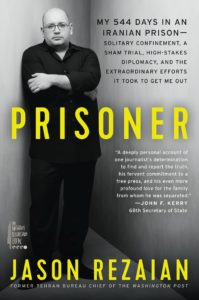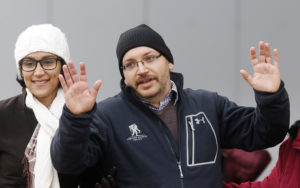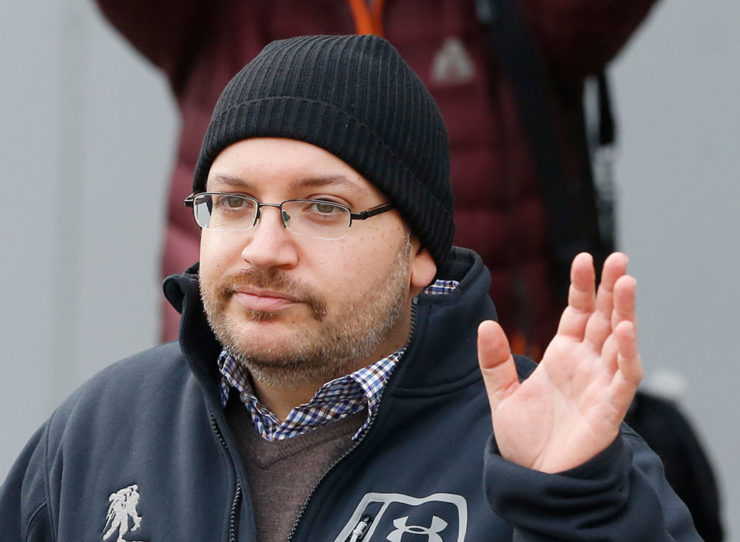Jason Rezaian’s twin allegiances were baked into his life and his journalism. He was born and raised in Marin County, California, the son of an Iranian father and American mother. He held dual citizenship in Iran and the U.S. In 2009, he moved to Tehran to freelance. Then, in 2012, he landed a rare opportunity to report for The Washington Post in advance of the Iranian presidential election.
By 2014, Rezaian was the Tehran bureau chief for The Post, writing news and feature stories. He was partial to stories involving food. Political news out of Iran was waning at the time, and Rezaian was drawn to the special tastes and rituals that accompanied food in Iran, but that few in the world knew about. In fact, on July 22, 2014, the day he and his wife Yeganeh Salehi, an Iranian journalist, were arrested on suspicion of spying, he was working on a story about the owner of an American-style diner in Tehran. Weeks earlier, he had appeared in an episode — filmed at a restaurant overlooking Tehran — with the late Anthony Bourdain of Bourdain’s CNN food and travel show “Parts Unknown.”
Rezaian at first dismissed the arrests as a mistake — one that would be cleared up before the night was over. But once he was separated from his wife, handed prison garb and locked in isolation in Evin prison, his situation grew in seriousness and surreality. His captors interpreted the phrase “radio silence” that he had used in a casual email as proof that he was a CIA plant; they read political significance into a Kickstarter account he had launched as a lark to raise money to bring avocados to Iran. Instead of the quick release he expected, Iranian officials used him as leverage in negotiations over the Iran nuclear deal.
Rezaian’s wife was released within three months. But as his own time in prison dragged on — and consequences became more dire — his brother, representatives of The Post, and then Secretary of State John Kerry, among others, lobbied on his behalf. Along with Rezaian’s wife, they navigated the tricky bureaucracy of the Iranian security agency. In January 2016, after 544 days in prison and a closed-door trial at which Rezaian was convicted of espionage, he was freed in a prisoner swap that was arranged on the eve of a historic nuclear agreement between Iran and western nations.

Rezaian returned to the United States with Salehi, where he joined the Nieman Fellow class of 2017. He is now an opinion writer for The Post and a contributor for CNN. His book, “Prisoner: My 544 Days in an Iranian Prison — Solitary Confinement, a Sham Trial, High-Stakes Diplomacy, and the Extraordinary Efforts It Took to Get Me Out,” was published this week by HarperCollins. In a New York Times’ review, the book is described as “more than just a memoir that reads like a thriller. It’s also an intimate family history, an anguished love letter to an ancient and broken homeland, and a spirited defense of journalism and truth at a time when both are under attack almost everywhere.”
Having met Rezaian when he was a Nieman Fellow, I was curious to hear about the writing of his first book, how he worked through the voice and structure, and what it was like to work with his editor on such a personal book.
“I realized so many times, while I was locked up, less is more,” he told me during our phone conversation; it was a lesson that was relevant to telling the story of his life and imprisonment. “I've never competitively run a 50‑yard dash or a marathon but I imagine that the difference between the two endeavors is the same as or similar to the differences between writing an 800‑word news article and an 80,000‑word book.”
Then he added this advice: “I think once you’ve written a book, you’ve got to be a real masochist if you don’t do it again. You learn so much the first time around that you should really take what you’ve learned and do it again.”
Our conversation below has been edited for length and clarity.
When you were in prison, did you think about writing a book about the experience?
Yes, I am a storyteller. It’s what I do for living. Here I am thrust in the sort of thing that I would have written about if it happened to somebody else.
There are all these absurd things happening to me, hard-to-imagine things happening to me. I thought to myself at some point, if I want to make sure that this didn’t happen for naught, I would have to write about it. If I didn’t, I think I probably would have been missing out on one of the few silver linings of the whole thing. I think that idea kept me going in some ways.
...if I want to make sure that this didn’t happen for naught, I would have to write about it.
One of the powerful things about this process of turning it into a book is that it allowed me to take these horrible things that happened to me, decide which parts of it I want to share, decide which parts of it I want to be able to laugh at, decide which parts of it I feel that a reader should empathize with or find poignant. In that regard, I feel like I’ve empowered myself and turned this from the horrible situation and experience that it was into a story that has value for me and hopefully lots and lots of other people.
Did you find a way to take or keep notes?
I had a few books and I was able over time to snatch pens from guards. I wasn’t supposed to have a pen, and I didn’t have paper that I could keep. What I started to do was take notes inside some of the books that I had. Since Persian is a language read right to left, I would write those notes on the sides of the page that would come up naturally for English speakers.
When an Iranian would pick up a book, they’d naturally flip it over and look at it from the other side, no matter what language it was in. On the off-chance they were trying to look through my book, they’d be looking in the other direction and potentially wouldn’t see my notes. Besides, my handwriting is the sort of handwriting that nobody else can read. It was one of my great attributes as a spy, as my interrogator would have you believe.
How did you determine the central focus of the book?Were you looking for a theme to build around, or did you primarily want the narrative to drive the book?
If the book was going to be just about my time in prison, that would have been an isolated story that wouldn’t really contribute to a larger conversation about Iran. It also would define me and my life experience in a way that I would have been uncomfortable with. It was important to get all of these other aspects of my life in and also to give that context of my family, my upbringing, my real love for Iran, my marriage, some of the heartache that my family had experienced prior to all of this. I knew that I couldn't start chronologically and say, “My father was born in Iran in 1939. My mother was...”

I played with juxtaposing moments from our ordeal with moments in my life. It took whittling away and finding little points where we could say, “That experience that I had in my life prior to moving to Iran was so harrowing that it fits right here because I'm feeling so helpless and alone.”
Here’s an opportunity for me to say, “Well, you know what? I’ve got anecdotal evidence to tell you that people survive,” and then I’d go into a story about loss and heartbreak. It took a long time to get to that. Just as the chapters and the sections play off present and past, there are moments intentionally and unintentionally interwoven into the story, that are a call and response from past to present. I hope that those are not plainly visible to people, but they are there for people who are paying attention.
What was your editor’s involvement?
My editor (Zachary Wagman) and I agreed that I was going to write the book in parts. The first piece that I sent him was the last chapter, my freedom. It was important for me to write that first because it was freshest in my mind.
I was having a lot of trouble writing about the hardest parts of prison, the hardest parts of solitary confinement and interrogations, not only because it was emotionally triggering for me — it certainly was — but also because I was trying to get the right voice. You're looking for the right amount of gravity.
My editor was really patient, especially in the early months, and didn’t get overly involved in telling me what to do. Then he started to give me notes, but not invasive ones. I applaud him for having a light touch and also for getting me from station to station in the process of writing a book. We built up that rapport over several months where he could say to me, “I know you think this is great, but it’s not going to work for other people.” One of the fortunate pieces of being a newspaper journalist is you have a pretty thick skin. You take edits or suggested edits well. You also should have the confidence to say, “Well, you know what...”
I remember the second draft that I sent in. He said, “This is great, but people don’t read 110,000‑word books. They read 85,000‑word books. Go back and take out whatever you need to take out.” Taking out 25,000 words is not that easy, especially when it’s your own life. He would suggest cuts here and there that would help bring it down, but there were certain things that I just thought, “No, this is going in my book.” He was always great in that he’d say, “It’s your story. You have the right to override me.”
There’s this one passage near the end of the book, where Obama’s giving the State of the Union address and my cellmate and I are watching it on TV. I go into this aside about how when Obama was elected, I wanted to get Persian portrait rugs commissioned so that I could have these rugs of Obama and give one to the White House. My editor cut that. I said, “No. Number One, that’s what I was thinking in that moment. Two, earlier in the book, I outlined how I was in the rug business and the fact that my father gave rugs to the returning hostages (the 52 Americans who were held in Iran from 1979 to 1981). It’s part of my story.
What do you hope readers, and especially journalists, take away from your book?
First and foremost, I hope it’s received as a very human story of hard‑to‑believe circumstances told well.
One piece of advice I give to journalists, especially those working in foreign countries is, “Don't break any eggs. Don’t make it any worse for people who live in places that you’re covering than it already is.”
One thing that I worried about a lot is, “Is this somehow going to make things worse for the people of Iran?” One piece of advice I give to journalists, especially those working in foreign countries is, “Don't break any eggs. Don’t make it any worse for people who live in places that you’re covering than it already is.” I think we don't naturally think about that enough. Oftentimes, we get access to an incredible story of triumph or woe about a person and a place. In the telling of it, we're more concerned about telling it in the most graphic or thrilling ways. There's very little concern for what's going to happen to that person after this information becomes publicly known to the world.
My advice to other journalists would be, Look at these stories that you’re telling from all sides, from the side of the people and places whose experience you’re trying to express to an American audience. What can that audience reasonably understand about that place and those people? Accept this as a great challenge to do work that explains oftentimes the unexplainable to a general audience. That’s what we should aspire to do.



